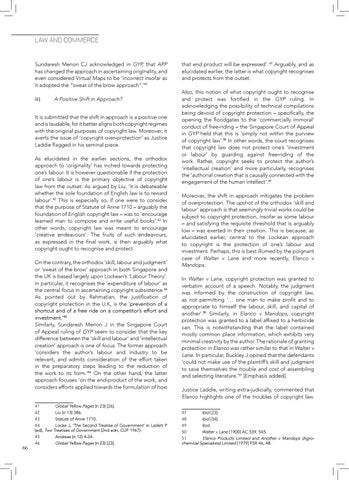LAW AND COMMERCE
Sundaresh Menon CJ acknowledged in GYP, that APP has changed the approach in ascertaining originality, and even considered Virtual Maps to be ‘incorrect insofar as it adopted the “sweat of the brow approach”.’41 iii)
A Positive Shift in Approach?
It is submitted that the shift in approach is a positive one and is laudable, for it better aligns both copyright regimes with the original purposes of copyright law. Moreover, it averts the issue of ‘copyright over-protection’ as Justice Laddie flagged in his seminal piece. As elucidated in the earlier sections, the orthodox approach to ‘originality’ has inched towards protecting one’s labour. It is however questionable if the protection of one’s labour is the primary objective of copyright law from the outset. As argued by Liu, ‘it is debateable whether the sole foundation of English law is to reward labour’.42 This is especially so, if one were to consider that the purpose of Statute of Anne 1710 – arguably the foundation of English copyright law – was to ‘encourage learned man to compose and write useful books’.43 In other words, copyright law was meant to encourage ‘creative endeavours’. The fruits of such endeavours, as expressed in the final work, is then arguably what copyright ought to recognise and protect. On the contrary, the orthodox ‘skill, labour and judgment’ or ‘sweat of the brow’ approach in both Singapore and the UK is based largely upon Lockean’s ‘Labour Theory’. In particular, it recognises the ‘expenditure of labour’ as the central focus in ascertaining copyright subsistence.44 As pointed out by Rahmatian, the justification of copyright protection in the U.K, is the ‘prevention of a shortcut and of a free ride on a competitor’s effort and investment.’45 Similarly, Sundaresh Menon J in the Singapore Court of Appeal ruling of GYP seem to consider that the key difference between the ‘skill and labour’ and ‘intellectual creation’ approach is one of focus. The former approach ‘considers the author’s labour and industry to be relevant, and admits consideration of the effort taken in the preparatory steps leading to the reduction of the work to its form.’46 On the other hand, the latter approach focuses ‘on the end-product of the work, and considers efforts applied towards the formulation of how
66
that end product will be expressed’. 47 Arguably, and as elucidated earlier, the latter is what copyright recognises and protects from the outset. Also, this notion of what copyright ought to recognise and protect was fortified in the GYP ruling. In acknowledging the possibility of technical compilations being devoid of copyright protection – specifically, the opening the floodgates to the ‘commercially immoral’ conduct of free-riding – the Singapore Court of Appeal in GYP held that this is ‘simply not within the purview of copyright law’.48 In other words, the court recognises that copyright law does not protect one’s ‘investment or labour’ by guarding against free-riding of the work. Rather, copyright seeks to protect the author’s ‘intellectual creation’ and more particularly, recognises the ‘authorial creation that is causally connected with the engagement of the human intellect’.49 Moreover, the shift in approach mitigates the problem of overprotection. The upshot of the orthodox ‘skill and labour’ approach is that seemingly trivial works could be subject to copyright protection, insofar as some labour – and satisfying the requisite threshold that is arguably low – was exerted in their creation. This is because, as elucidated earlier, central to the Lockean approach to copyright is the protection of one’s labour and investment. Perhaps, this is best illumed by the poignant case of Walter v Lane and more recently, Elanco v Mandops. In Walter v Lane, copyright protection was granted to verbatim account of a speech. Notably, the judgment was informed by the construction of copyright law, as not permitting ‘… one man to make profit and to appropriate to himself the labour, skill, and capital of another’.50 Similarly, in Elanco v Mandops, copyright protection was granted to a label affixed to a herbicide can. This is notwithstanding that the label contained mostly common place information, which exhibits very minimal creativity by the author. The rationale of granting protection in Elanco was rather similar to that in Walter v Lane. In particular, Buckley J opined that the defendants ‘could not make use of the plaintiff’s skill and judgment to save themselves the trouble and cost of assembling and selecting literature.’51 [Emphasis added] Justice Laddie, writing extra-judicially, commented that Elanco highlights one of the troubles of copyright law.
41
Global Yellow Pages (n 23) [26].
42
Liu (n 13) 386.
47
ibid [23].
43
Statute of Anne 1710.
48
ibid [34].
44 Locke J, ‘The Second Treatise of Government’ in Laslett P (ed), Two Treatises of Government (2nd edn, CUP 1967).
49
ibid.
45
Andreas (n 12) 4-34.
50
Walter v Lane [1900] AC 539, 545.
46
Global Yellow Pages (n 23) [23].
51 Elanco Products Limited and Another v Mandops (Agrochemical Specialists) Limited [1979] FSR 46, 48.
